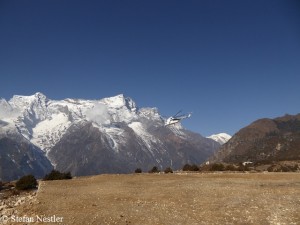Helicopter transport flights to Everest high camps
Time does not stand still, even in Khumbu. Two things have changed dramatically in the region around Mount Everest between my first visit in 2002 and my second last March. Firstly, the sanitary facilities – on average – have become much more modern and cleaner than 14 years ago. Secondly, the aircraft noise has increased significantly. On a clear day, helicopters are flying – as I felt, steadily – through the valley from Lukla to Namche Bazaar and also further up towards Everest Base Camp.
Cheaper than mules
“Meanwhile, a big part of material transport is done by helicopter,” Ang Dorjee Sherpa, owner of a lodge in Namche, told me. “That’s almost cheaper than the transportation by mules.” Not only material is transported, even people use helicopter transfer. When we sat on the terrace of the Everest View Hotel, above Namche Bazaar, drinking an (expensive) milk tea, we met a couple from the United States that virtually smelled of money. The two had just landed next to the hotel by helicopter along with their private pilot. “We flew over Everest Base Camp and Khumbu Icefall and afterwards even turned a round through the Gokyo valley”, both said enthusiastically. But you have not got a real feeling for these beautiful mountains, I thought.
More than 80 loads less cross the Icefall
As the US blogger and mountaineer Alan Arnette – he wants to climb Lhotse this spring – reported from Everest Base Camp, the Nepalese government has allowed for the first time to fly climbing equipment by helicopter up to Camp 1 at about 6,000 meters: ropes, anchors and bottled oxygen. All in all, says Alan, it is more than 80 loads that have not to be carried by Sherpas through the Khumbu Icefall. Although it is a contribution to safety, the helicopter transport flights to high camp also mean another step of commercialization of Mount Everest.
Many cracks and deep holes
Even after the huge avalanche which had been triggered on the seven-thousander Pumori by the earthquake on 25 April 2015, had hit the Everest Base Camp and killed 19 people, the Nepalese government had agreed to material transport by helicopter to Camp 1. However, it had not happened, because the season had ended prematurely, as already in 2014 after the avalanche in the Khumbu Icefall with 16 dead Nepalese climbers.
The Icefall Doctors speak of very difficult conditions this spring, after the earthquake that hit Nepal on Monday exactly one year ago. “I have never seen so many cracks and deep holes on the path to the summit of Sagarmatha,” said Ang Kami Sherpa, head of the specialists who prepare and secure the route through the Icefall and further up. “It’s dangerous this year.” By their own account, the government has issued 289 Everest permits for foreign climbers this season. Many of them use their permits from 2014 or 2015, the validity of which had been extended by five respectively two years.









